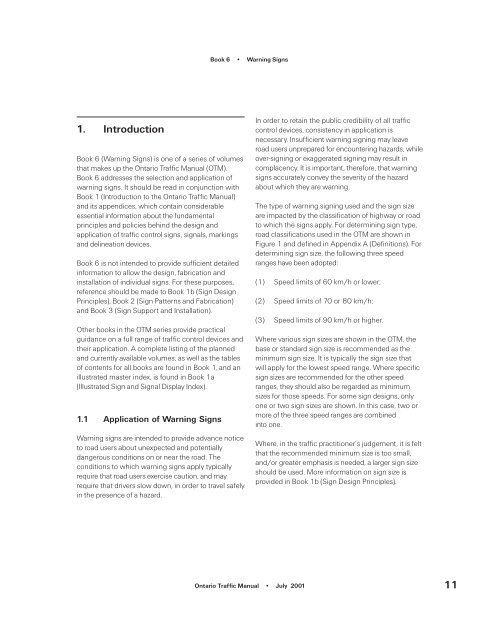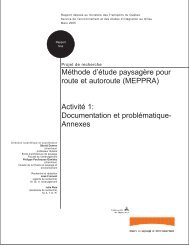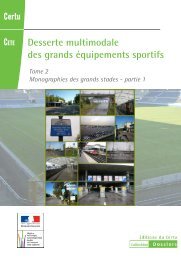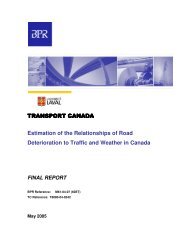Create successful ePaper yourself
Turn your PDF publications into a flip-book with our unique Google optimized e-Paper software.
1. Introduction<br />
Book 6 (Warning Signs) is one of a series of volumes<br />
that makes up the <strong>Ontario</strong> Traffic Manual (OTM).<br />
Book 6 addresses the selection and application of<br />
warning signs. It should be read in conjunction with<br />
Book 1 (Introduction to the <strong>Ontario</strong> Traffic Manual)<br />
and its appendices, which contain considerable<br />
essential information about the fundamental<br />
principles and policies behind the design and<br />
application of <strong>traffic</strong> control signs, signals, markings<br />
and delineation devices.<br />
Book 6 is not intended to provide sufficient detailed<br />
information to allow the design, fabrication and<br />
installation of individual signs. For these purposes,<br />
reference should be made to Book 1b (Sign Design<br />
Principles), Book 2 (Sign Patterns and Fabrication)<br />
and Book 3 (Sign Support and Installation).<br />
Other books in the OTM series provide practical<br />
guidance on a full range of <strong>traffic</strong> control devices and<br />
their application. A complete listing of the planned<br />
and currently available volumes, as well as the tables<br />
of contents for all books are found in Book 1, and an<br />
illustrated master index, is found in Book 1a<br />
(Illustrated Sign and Signal Display Index).<br />
1.1 Application of Warning Signs<br />
Warning signs are intended to provide advance notice<br />
to road users about unexpected and potentially<br />
dangerous conditions on or near the road. The<br />
conditions to which warning signs apply typically<br />
require that road users exercise caution, and may<br />
require that drivers slow down, in order to travel safely<br />
in the presence of a hazard.<br />
Book 6 Warning Signs<br />
In order to retain the public credibility of all <strong>traffic</strong><br />
control devices, consistency in application is<br />
necessary. Insufficient warning signing may leave<br />
road users unprepared for encountering hazards, while<br />
over-signing or exaggerated signing may result in<br />
complacency. It is important, therefore, that warning<br />
signs accurately convey the severity of the hazard<br />
about which they are warning.<br />
The type of warning signing used and the sign size<br />
are impacted by the classification of highway or road<br />
to which the signs apply. For determining sign type,<br />
road classifications used in the OTM are shown in<br />
Figure 1 and defined in Appendix A (Definitions). For<br />
determining sign size, the following three speed<br />
ranges have been adopted:<br />
(1) Speed limits of 60 km/h or lower;<br />
(2) Speed limits of 70 or 80 km/h;<br />
(3) Speed limits of 90 km/h or higher.<br />
Where various sign sizes are shown in the OTM, the<br />
base or standard sign size is recommended as the<br />
minimum sign size. It is typically the sign size that<br />
will apply for the lowest speed range. Where specific<br />
sign sizes are recommended for the other speed<br />
ranges, they should also be regarded as minimum<br />
sizes for those speeds. For some sign designs, only<br />
one or two sign sizes are shown. In this case, two or<br />
more of the three speed ranges are combined<br />
into one.<br />
Where, in the <strong>traffic</strong> practitioner’s judgement, it is felt<br />
that the recommended minimum size is too small,<br />
and/or greater emphasis is needed, a larger sign size<br />
should be used. More information on sign size is<br />
provided in Book 1b (Sign Design Principles).<br />
<strong>Ontario</strong> Traffic Manual July 2001 11





